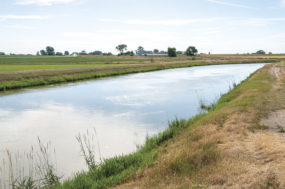From my end of the equation, I had no desire to have to recover twice. Before the operation I would get in a car by falling in butt-first and then dragging my legs in behind me. At ten weeks after surgery I was back to doing at least that well.
Operation day was a Tuesday. Go-home day was the next Sunday. I made it from the car to the steps using a walker. I sat down on a chair which my son Dan managed to drag up the steps. I realized I was not as mobile as I thought. Two days later for the trip in to the doctor’s office we borrowed a wheelchair to get me down the steps. Dave Gilbert came over and did the heavy work of hauling my heavy carcass out of the house.
When we got back my wife wanted to know who to call to help since Dan was gone with his hay truck. I instructed her to just flag down the first car that came down the lane. (We live on a gravel road that is more of a glorified long driveway than a road, but we do have some through traffic.) The first car that came along stopped. It was occupied by two young Mexican fellows who spoke no English. They were about to drive on when they noticed me in the wheelchair waving at them. When they came over to me, I said to them, pointing to the door of the house, “Esta problema grande por entro la casa.” It was adequate Spanish, and they got me inside the house without incident.
Three days later I was able to navigate the stairs with the walker. Getting in and out of a vehicle was the biggest hurdle for awhile. What I wouldn’t have given for the use of an older two-door Cadillac for a few weeks. Even my 1996 Lincoln Towncar was a hassle. When your knees will not bend far enough to clear the door jamb, nor will the muscles work to lift your legs, it takes longer to get in the car than the 35-mile trip to town. I took the oak stock cane I used for a walking cane with me from the start. I could slip the curved handle under my foot and, by pulling on the other end of the cane, lift up my feet and legs.
Things progressed steadily from there on. I think part of being a physical therapist is being a good coach. Dave Hasse at the Moses Lake Clinic physical therapy department certainly had that figured out.
Going into this, the doctor’s office gave me a timetable of six weeks before I could drive myself in to therapy and three months before I would want to go back to work. I was driving at two-and- a-half weeks and in the office part-time. (That’s where I was driving.) At about four weeks, I was to work most of every day.
At seven weeks they told me physical therapy was over. At ten weeks, I’m still ice-packing the knees at least once a day, and they tell me to expect the swelling and tenderness to last for up to a year. When they told me how long I would be out of commission, they failed to write into the formula, “this is an old hay hauler!”
Early on as I was leaving the physical therapy building a fellow passed me as I crept along using my walker. He said, as he passed, “Kind of hard to cast your praises to the Lord when you’re in that kind of pain, isn’t it?” I told him that actually it was easier. “How can you hope to begin to understand the gifts the Lord has given us if you never have opportunity to experience a little pain yourself?” I said.
The silence was wonderful. PD











